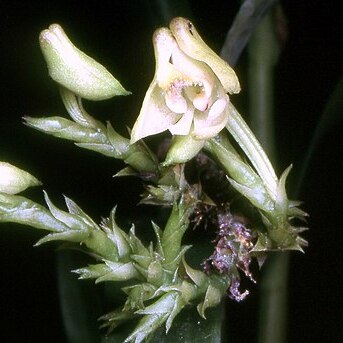Plants 100-300 mm tall; stems covered by imbricating leaf-sheaths, but not swelling into pseudobulbs; leaves 3-6, erect, leathery, lorate-elliptic, rounded to obtuse, minutely unequally bilobed, drying black, 40-100 x 10-25 mm. Inflorescences simple or rarely branched, shorter to slightly longer than the leaves, sparsely pubescent; bracts narrowly lanceolate, acuminate, 3-5 mm long. Flowers glabrous; sepals cream, yellow, green or orange, petals and lip dull cream to greenish veined with maroon. Sepals unequal, apiculate; median sepal flat, narrowly triangular, 6-11 x 3.5-4.2 mm; laterals obliquely triangular, 8-13 x 7-10 mm. Petals linear-spathulate, acute, 5-10 x 1.3-2 mm. Lip subspathulate, obscurely 3-lobed, upper surface pubescent, 12 x 7 mm, disc with a knoblike callus; midlobe triangular, acute, 1-3 mm long, apex reflexed; side lobes porrect, rounded, 1-2 mm tall; mentum conical, 6.5-8.5 mm. Gynostemium stout, 2 mm tall. Capsules obconi-cal, 18-21 x 7 mm.
Epiphyte, up to 250 mm tall. Leaf apex rounded, leaves fleshy. Flowers 1-8 per stem which has few or no branches. Lip white with faint purple streaks on side lobes. Flowers yellowish green, often suffused with reddish brown on outer surface.
Inflorescence (floral axis) 3–13 cm long, of similar length to the leaves, unbranched, or occasionally 1–3-branched, sparsely pubescent, up to 12-flowered.
Lip with a long claw, obscurely 3-lobed in the apical half, recurved, 6.6–11 × 6–8 mm; mid-lobe 2.5–3 × 2.6–3 mm, triangular, subacute; side lobes rounded.
Dorsal sepal 5.5–10 × 2.5–4 mm, ovate, acute; lateral sepals 8.5–15 × 6–9.5 mm, obliquely triangular, acute or acuminate; mentum 5.5–9 mm long, conical.
Flowers glabrous on outer surface, green, yellow-green or bright yellow, sometimes purple-tinged; lip creamy-white, purple-veined.
Leaves 8.5–13 × 0.7–2 cm, ligulate or linear-lanceolate, obtuse at apex, dark green, often purplish.
Erect, epiphytic or lithophytic herb 8–25(50) cm tall, drying black.
Stems cylindrical, 2–5-leaved, covered with black, tubular sheaths.
Petals 5–7.5 × 1–2 mm, oblanceolate to spathulate.
Bracts 3–7 mm long, ovate, acuminate.
Pedicel and ovary 3–9 mm long.
Column 2.5 mm long.

